As the demand grows for faster and more reliable electronics for use in critical aerospace, defence and medical applications, more PCB (printed circuit board) fabricators are incorporating fibre optics into their PCB designs.
Fibre optics on PCBs provide higher bandwidth connectivity, are stronger than traditional components and typically take up less space on the PCB. They don’t need a power boost to extend the signal length and are less prone to electromagnetic interference, helping to ensure PCB longevity.
Keep the Connections Clean
PCB fabricators already know that their PCBS must be clean to operate reliably. It is the same for fibre optics. Contamination on fibre connection points, also known as end faces, can disturb or block the optical signal. This causes problems including intermittent operation, slow data speeds or even a complete network shutdown. Cleanliness is imperative for the fibre connections, and ultimately the finished PCB, to perform without fault.
Clean with Care
Fibre optic components do require special handling and care including proper cleaning during installation and prior to connection. Fibre connectors cannot be cleaned with the same products used to clean the PCB itself; that will not nearly be clean enough. It takes the right tools and cleaning fluids to get the fibre cleaning job done right.
Identify and Remove the Contaminants
Like many PCB contaminants, fibre contamination can’t be seen with the naked eye. Therefore, it is common to use a specialised 200x or 400x digital inspection scope to identify microscopic dust particles, salt or fingerprint oils. Inspection scopes also allow technicians to inspect end faces after cleaning them to ensure the contamination is removed and they meet International Electrotechnical Commission (IEC) standards. The IEC published the fibre end face cleaning specification 61300-3-35 as guide for fibre optic installation technicians in identifying contaminants on end faces and how to best remove them. Section 5.3 of IEC 61300-3-35 recommends using the three-step process of inspect, clean, inspect for end faces.
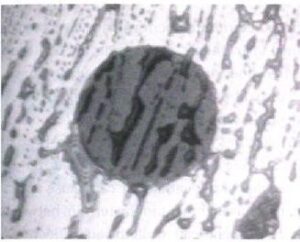
Fingerprint oils seen with a specialised 200x inspection scope
ICI (Inspect, Clean, Inspect)
First, inspect the connector end faces to identify the size, area, and location of end face contaminants. Second, clean the end faces, if necessary, to remove the contamination. Finally, re-inspect the end faces to ensure they are clean. Repeat this process until absolutely certain the end faces are clear of all contaminants. The inspect-clean-inspect process, typically takes less than 60 seconds and is a fast and accurate way to confirm end faces are clean.
Stay Away from Static
Electrostatic charges often attract dust to the end faces and can hold it there for weeks or even months until the static charge finds a conductive path for it to dissipate. iNEMI, IPC, BICSI and other fibre industry organisations recommend “wet to dry”’ cleaning as the most effective method to quickly dissipate the static and make it easier to wipe away the particle contamination. Wet to dry cleaning also dissolves oils found on the end faces, making cleaning more effective.
How to Wet to Dry Clean
To wet to dry clean, carefully apply a small amount of high-purity cleaning fluid on the corner of a dry, lint-free wipe. Starting at the wet section, slowly swipe the fibre end face towards the dry section of the wipe.
If using a cleaning stick, wet the tip of the stick directly from the dispenser cap of the cleaning fluid can or touch it to a cleaning wipe moistened with cleaning fluid. Then insert the stick tip into the end face to clean.
Be sure not touch the wipe or stick tip with fingers or clothing. Trace amounts of skin-oil will contaminate a clean wipe or stick making it useless. If you touch or drop a wipe or stick onto the ground, discard it and start over with a new one. Once cleaning is complete, discard the wipe or stick and inspect the end face to confirm all the contaminants are removed.
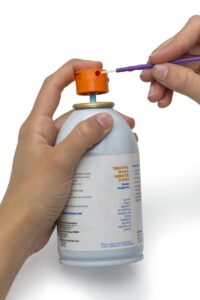
Wet-to-dry cleaning with an engineered fluid dissipates static and makes it easier to remove connector contamination
Not Just Any Tool Will Do
For the most effective cleaning, it’s important to know which fibre cleaning tools to use. Here are the basics to have for successful fibre optic connector cleaning.
Optical Grade Cleaning Fluid: When wet to dry cleaning, use only high-purity, nonflammable fluids. They are engineered to be fast-drying, static dissipative and should come in hermetically sealed cans to keep them clean. Avoid using water-based cleaning solutions or pure isopropyl alcohol (IPA). Both are hard to find in high purity packaging and are nearly impossible to keep clean during day-to-day use.
Water-based products and IPA are slow-drying and can leave moisture on the end faces. If the moisture isn’t completely removed before mating the end faces, the laser-energised fibre can instantly vaporise the trapped liquid into a gas, causing an explosion through the sudden expansion of the vapours. They also tend to leave a hazy film behind as they dry.
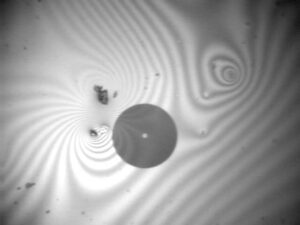
IPA tends to leave a hazy film behind as it dries
Avoid Presats
Beware of presaturated cleaning materials. Presaturated wipes and cleaning sticks often contain microscopic plasticiser contaminants drawn from their packaging. Those contaminants typically transfer to the end face during cleaning.
Add Mechanical Cleaning Action
Salts, usually left from skin oil, are often not fully removed with cleaning fluids alone. Adding mechanical cleaning action with a cleaning wipe or stick helps scrub the residue away. There are two primary tools for cleaning fibre end faces: a specialty wipe for male-end connectors and a swab or stick tools for female-end connectors.
Lint-Free Wipes: Avoid tissues, shirt sleeves and paper towels that deposit lint and spread contaminants around. Instead, opt for an optical-grade wipe, specifically engineered for fibre cleaning. Fabric wipes are especially good for male end-face cleaning. They are highly absorbent to wick away the contamination without generating static or lint, scratching surfaces or leaving residue behind. It’s best to select smaller wipes that come in sealed packages to keep them dry and clean until ready to use.
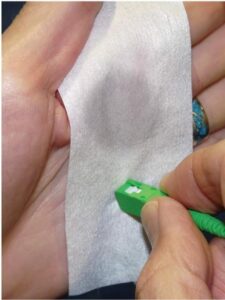
Fabric wipes are especially good for male end-face cleaning
Cleaning Sticks:
Fibre cleaning sticks are engineered to specifically match the internal configuration and size of the female end-face. However, when using cleaning sticks, it is important to only rotate the stick in one direction to prevent redepositing contaminants. Typically six rotations in one direction is enough to remove any contamination. Use only use one stick per end face to avoid cross-contamination. Keep the sticks clean in their resealable pouch until ready to use.
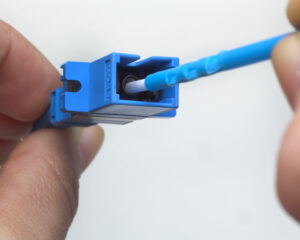
Fibre cleaning sticks are engineered to specifically match the internal configuration and size of the female end-face
Mechanical Click-to-Clean Tools: Mechanical click-to-clean tools are fast to use and good for applications with light levels of contamination. Like the other cleaning tools, be sure to keep them clean by leaving the protective cap on the tool until ready to use.
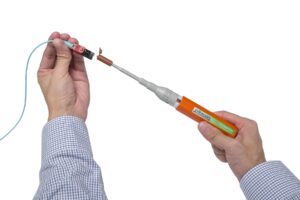
Mechanical click-to-clean tools are quick to use and good for efficiently cleaning a high-volume of connectors
Fluid, Tools and Expertise
As fibre components continue to make their way onto PCBs, knowing how to clean fibre end faces is important. To help guarantee fibre optic end face cleanliness, reliability and performance, use only specially-engineered fibre optic cleaning tools and follow the recommended three-step cleaning process of inspect ,clean, inspect.
For those looking for help in selecting fibre optic cleaning tools and fluids, partner with a supplier that specialises in fibre optic cleaning. They can provide advice on the best cleaning solutions and methods to use for success.
Author information:
Liam Taylor is European Business Manager, Fibre Optics at MicroCare UK Ltd and a member of IEC/SC 86B Working Group 4. MicroCare, LLC manufactures the Sticklers™ brand of specialist fibre cleaning tools.